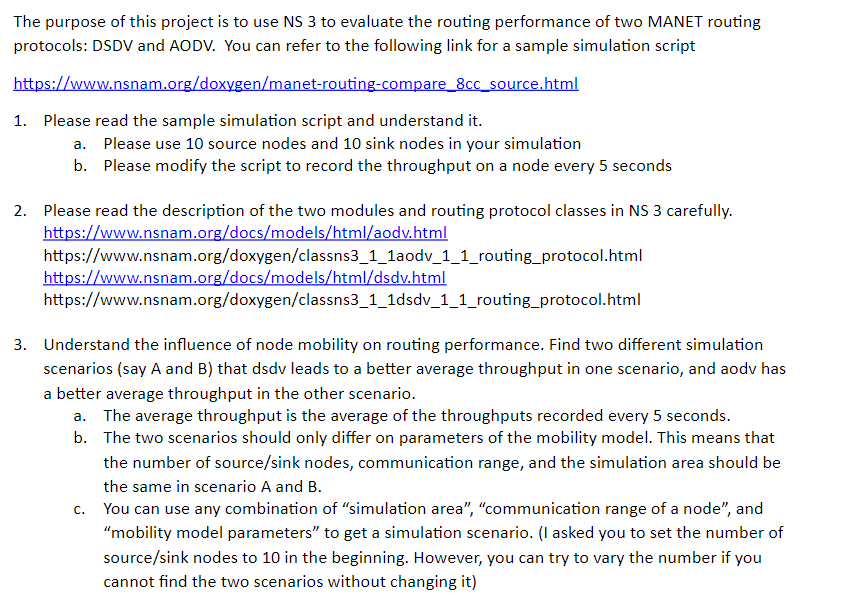

The purpose of this project is to use NS 3 to evaluate the routing performance of two MANET routing protocols: DSDV and AODV. You can refer to the following link for a sample simulation script https://www.nsnam.org/doxygen/manet-routing-compare_8cc_source.html 1. Please read the sample simulation script and understand it. Please use 10 source nodes and 10 sink nodes in your simulation Please modify the script to record the throughput on a node every 5 seconds a. b. 2. Please read the description of the two modules and routing protocol classes in NS 3 carefully https://www.nsnam.org/doxygen/classns3_1_1aodv_1_1_routing_protocol.html https://www.nsnam.org/doxygen/classns3_1_1dsdv_1_1_routing_protocol.html Understand the influence of node mobility on routing performance. Find two different simulation scenarios (say A and B) that dsdv leads to a better average throughput in one scenario, and aodv has a better average throughput in the other scenario. 3. The average throughput is the average of the throughputs recorded every 5 seconds. The two scenarios should only differ on parameters of the mobility model. This means that the number of source/sink nodes, communication range, and the simulation area should be the same in scenario A and B a. b. c. You can use any combination of "simulation area", "communication range of a node" and "mobility model parameters" to get a simulation scenario. (I asked you to set the number of source/sink nodes to 10 in the beginning. However, you can try to vary the number if you cannot find the two scenarios without changing it) The purpose of this project is to use NS 3 to evaluate the routing performance of two MANET routing protocols: DSDV and AODV. You can refer to the following link for a sample simulation script https://www.nsnam.org/doxygen/manet-routing-compare_8cc_source.html 1. Please read the sample simulation script and understand it. Please use 10 source nodes and 10 sink nodes in your simulation Please modify the script to record the throughput on a node every 5 seconds a. b. 2. Please read the description of the two modules and routing protocol classes in NS 3 carefully https://www.nsnam.org/doxygen/classns3_1_1aodv_1_1_routing_protocol.html https://www.nsnam.org/doxygen/classns3_1_1dsdv_1_1_routing_protocol.html Understand the influence of node mobility on routing performance. Find two different simulation scenarios (say A and B) that dsdv leads to a better average throughput in one scenario, and aodv has a better average throughput in the other scenario. 3. The average throughput is the average of the throughputs recorded every 5 seconds. The two scenarios should only differ on parameters of the mobility model. This means that the number of source/sink nodes, communication range, and the simulation area should be the same in scenario A and B a. b. c. You can use any combination of "simulation area", "communication range of a node" and "mobility model parameters" to get a simulation scenario. (I asked you to set the number of source/sink nodes to 10 in the beginning. However, you can try to vary the number if you cannot find the two scenarios without changing it)








